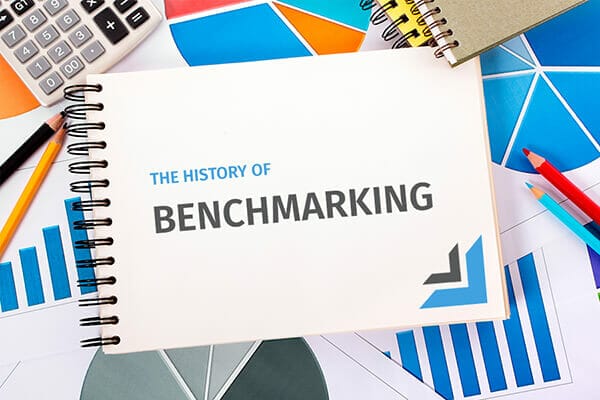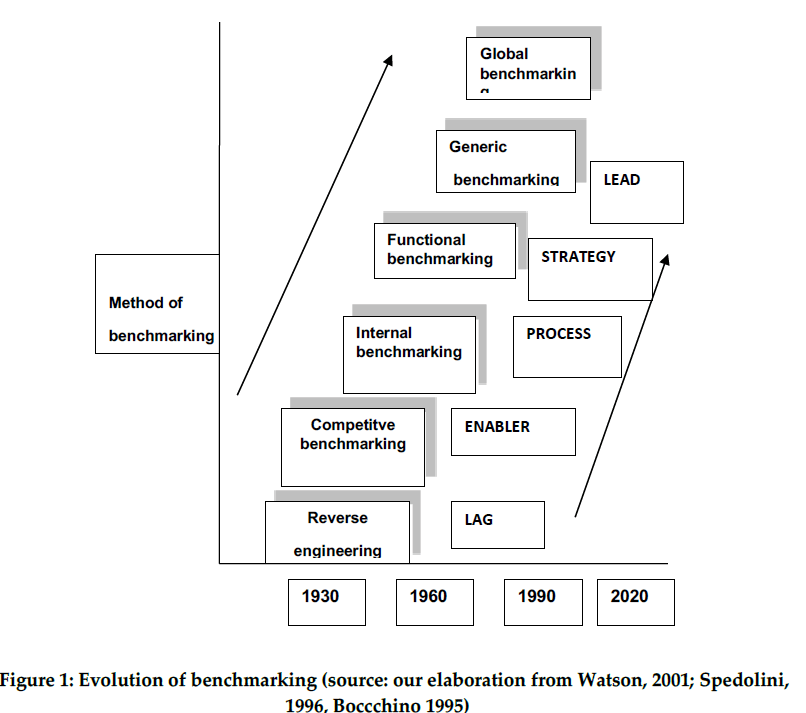
Today, benchmarking is a fundamental business process which drives business performance and ensures continuous improvements. Like all business processes, benchmarking has continued to evolve to provide greater insights for business owners. This article reviews the history of benchmarking, and it transitioned from being a physical mark on a bench/building to a global business practice.
The history of benchmarking - aka the “bench-mark”
‘Benchmark,’ as a term, has been used in various forms for hundreds of years.
In the same vein as many other common business terms -such as strategy, campaigns and tactics – one of these terms was in relation to military activity.
The term coincided with the introduction of gunpowder in firearms during the mid-1800’s. Marksmen would fire a variety of firearms from the same point on a bench and then compare the results. This mark became known as ‘the bench mark’. It became a way to select the most suitable weapon for the war ahead.[i]
During the Victorian era, the history of benchmarking tells us that benchmarks were also widely used in the UK. Masons would carve a mark into vertical structures such as buildings and monuments to show altitudes above sea levels.[ii] As a term, benchmarking is also cited as referring to the way a cobbler would measure a foot size on a bench.[iii]
Despite the various uses, ‘to benchmark’ became common language when measuring and/or comparing one thing against another.
The first Business Benchmarkers
The first formally recorded business benchmarkers emerged in the early 1800’s during the industrial revolution. Industrialists such as Francis Lowell invested time and money into studying his manufacturing competitors and determining the techniques he could use for his own factories. Henry Ford famously visited various industries such as slaughterhouses to develop his assembly lines. This early form of competitor benchmarking became more common practice during the industrial revolution.
In this era, manufacturing became highly competitive. Factory owners focused on continuous improvements to develop high quality products at affordable costs in minimal time.
The beginning of modern benchmarking
In the early 1900’s, benchmarking was still a process of business owners studying their competitors’ techniques. However, as mechanical engineering advanced, so did the style of benchmarking. In the mid-1900’s, businesses began undertaking reverse engineering of competitor products.
The era of reverse engineering occurred in the 1950s to the mid-1970s when companies were doing exactly as the name implies; tearing things apart, examining them and then improving upon them before putting them back together.[iv]
Reverse engineering enabled companies to examine and improve on new technologies and understand what competitors were building. This technique grew with the introduction of computers and automation. However, the concept meant that companies were always one step behind their competitors – as they were analysing work that had already been done.

Therefore, a few innovative companies sought to undertake a more proactive approach to determine not just what their competitors where producing, but how they were implementing production.
A Modern Competitive Approach
This new phase was championed by Xerox, whom many argue is the founder of modern benchmarking. In the 1980’s, Xerox undertook an intensive benchmarking process against its Japanese competitors. Whilst the products themselves were comparable on the surface, the company was rapidly losing market share due to Japanese companies being able to produce cheaper, higher quality printers in much faster time frames.
Xerox therefore assessed 230 performance areas across the business to improve not only the quality of the product, but also the manufacturing efficiencies, internal processes and overall value chain. The results were so successful that Xerox won the Federal Government’s Malcolm Baldridge National Quality Award in 1989 and the company states that benchmarking saved the business.
“The formal definition of benchmarking is the continuous process of measuring our products, services and practices against those of our toughest competitors or companies renowned as leaders.”
Robert C. Camp, “A bible for benchmarking, by Xerox”
The Benchmarking Phenomenon
The Xerox case study was a catalyst for the benchmarking phenomenon of the 1980/90’s. During this period, businesses continuously refined, studied and developed practices to give companies a competitive edge.
In addition to competitive benchmarks, companies began using benchmarks as a way to measure internal standards. This became popular in large organisations, franchises and government departments where teams could work together to meet the benchmarks – or set the benchmark.
It was also during this period that The Benchmarking Group’s partner FMRC (Financial Management Research Centre) established the first Australian Business Benchmarks in conjunction with the University of New England. It was the first time a wide range of Australian businesses were analysed to create industry benchmarks.
Today’s Benchmarks
Today, benchmarking not just for the manufacturing industry; it can be a core strategy for any business.
For large multi-national companies, the focus is both benchmarking on a global scale (markets, competitors, processes), as well as ensuring internal productivity targets (sales targets, team innovation and training). Leaders can use benchmarking to drive high-level strategic decisions such as entering new markets, or implement daily operational changes.
For smaller companies, benchmarking gives business owners an opportunity to evaluate how their company performs against competitors. It highlights their strengths and areas for improvement. It provides businesses a blueprint for expenditure, KPI’s regarding employee productivity, and revenue goals the organisation could achieve.
The Future of Benchmarking
Companies can benchmark almost any criteria they wish against competitors or internally. As technology evolves, benchmarking will be less about reviewing hundreds of data points, and more about how data is analysed. Big data will provide insights that have never been possible and smart analytics will give companies niche and individualised outcomes to focus on.
“We are drowning in information but starved for knowledge.”
John Naisbitt
The history of benchmarking shows the true value lies in how business leaders leverage their insights to gain a competitive advantage. No matter how much the process of benchmarking changes, we believe the future of benchmarking will be not WHAT can be benchmarked, but HOW business owners use benchmarks to drive business performance.
References for “The History of Benchmarking”
[i] https://en.wikipedia.org/wiki/Benchmarking
[ii] https://ashleycowie.com/blog/decoding-britains-lost-masonic-secret
[iii] https://www.scribd.com/document/264376355/Benchmarking-Definition-and-History
[iv] https://www.hotstats.com/hotel-industry-resources/the-story-of-benchmarking-history-processes-and-practice
